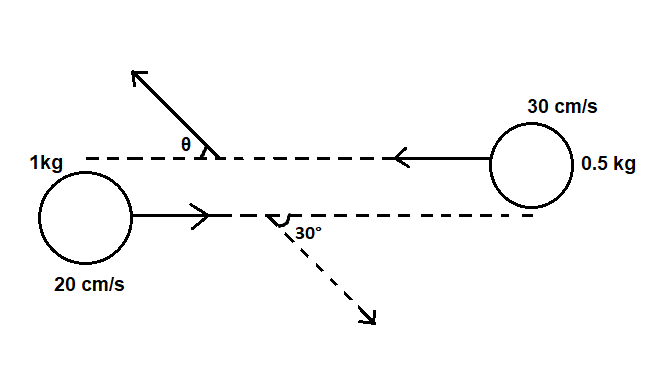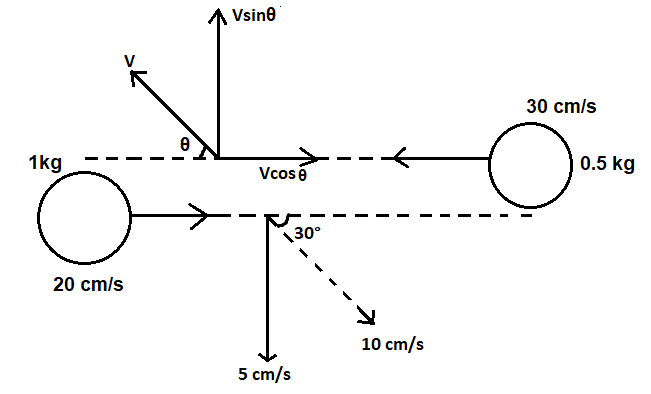Question
Question: Two balls collide bounce off each other as shown in the figure. The \[1kg\] ball has a speed \(10cm/...
Two balls collide bounce off each other as shown in the figure. The 1kg ball has a speed 10cm/s after collision. The velocity of the 0.5kg ball will be

(A) 36cm/s
(B) 24cm/s
(C) 12.4cm/s
(D) 18cm/s
Solution
Hint According to Newton’s second law of motion, the rate of change of momentum of a body is directly proportional to the applied force and the change takes place in the direction of the force. We know that the momentum of a body is equal to the product of mass and velocity. So if we calculate the momentum we can find the velocity from that.
Formula used:
P=mv (Where P stands for the momentum of the object, mstands for the mass of the object, and v stands for the velocity of the particle.)
Complete Step by step solution

The figure given above shows how we can resolve the velocity vector into its components.
After the collision, the 1kgball will have a velocity 10cm/s
The angle between the velocity vector and the path of the ball is given as, 30∘
From this, we can find the sin component of the velocity vector of1kgthe ball as,
vsinθ=10sin30∘=5cm/s
Let us take the velocity of the 0.5kgas v and the sin and cos components of the velocity vector are vsinθand vcosθrespectively.
According to the principle of conservation of linear momentum,
The momentum along the ydirection will be,
Pi=Pf=0…………………………………………………………………(1)
Where Pi is the initial momentum and Pfis the final momentum
We know that the momentum of a body is,
P=mv
Substituting the values of mass and the component of velocity in ydirection in the equation (1)
1×5=(0.5)vsinθ=0
From this equation, we can write
5−(0.5)vsinθ=0
We can write
vsinθ=0.55=10cm/s
From this, we get that
vsinθ=10cm/s…………………………………………………………………………………..(2)
The momentum of the body in x-direction is,
Pi=Pf
i.e.
m1u1+m2u2=m1v1cosθ+m2v2cosθ………………………………………………………..(3)
It is given that,
m1=1kg
u1=20cm/s
m2=0.5kg
u2=30cm/s
v1cosθ=10cos30∘=1023=53
We have to find the value of v2from equation (3)
Substituting the values in equation (2), we get
1×20−0.5×30=1×53−0.5×v2cosθ
Calculating,
20−15=53−0.5vcosθ
53−5=0.5vcosθ
From this we get
vcosθ=0.55(3−1)=10(3−1)
We can write
vcosθ=10(3−1)………………………………………………………………….(4)
Squaring and add equation (2) and (4)
v2sin2θ+v2cos2θ=102+(10(3−1))2
This can be written as,
v2(sin2θ+cos2θ)=102(1+3+1−23)
v2=102(5−23) (∵sin2θ+cos2θ=1)
We can get the velocity by taking the square root of the above equation,
v=105−23
This will be,
v=101.5358
i.e.
v=12.4cm/s
The answer is:Option (C): 12.4cm/s
Note
In all collisions the total linear momentum is conserved. But the kinetic energy of the system need not be conserved. The collision in which the total kinetic energy is conserved is called an elastic collision. If the total kinetic energy of a system is not conserved after collision then it is called an inelastic collision.
